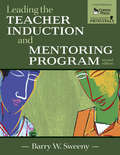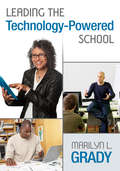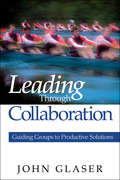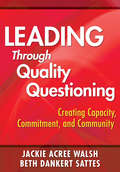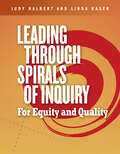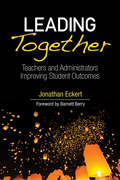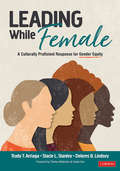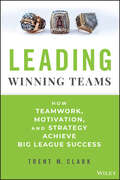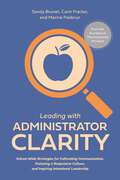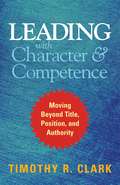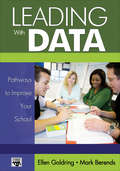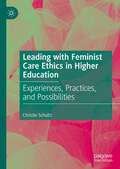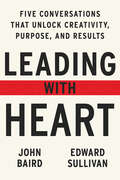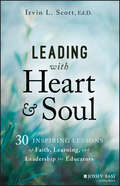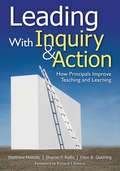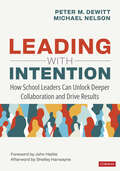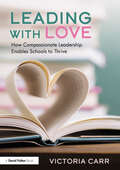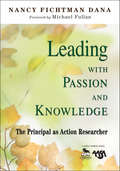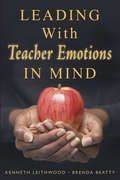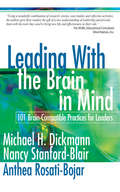- Table View
- List View
Leading the Teacher Induction and Mentoring Program
by Barry W. SweenyUse these step-by-step strategies to develop and implement a proven program that links to districtwide goals and results in highly qualified teachers and increased student achievement.
Leading the Technology-Powered School
by Marilyn L. Grady"A straightforward and easy read about what it takes to become a tech savvy leader in today′s educational setting."—Nathan Flansburg, PrincipalValentine Hills Elementary School, Arden Hills, MN"The topic is timely and this book is practical and relevant to K–12 schools across the country. The tables, checklists, rubrics, research-based models, and website recommendations are terrific."—Minjuan Wang, Associate Professor of Educational TechnologySan Diego State UniversityDon′t just ride the technology train – drive itToday′s children would rather text than talk, use apps instead of maps, and carry their phones, computers, cameras, and stereos in their palms. They need an active classroom, interdisciplinary curriculum, and project-based instruction that mirrors their lives outside the classroom. Author Marilyn L. Grady offers a cut-to-the-chase approach for busy principals who want to successfully lead with technology for enhanced student learning. This helpful resource shows school leaders how toDevelop a technology leadership teamImplement professional development Assess technical needs, student learning, and teacher performanceAddress cyber safety effectivelyIncluded are field-tested tools in digestible "bytes" that bridge theory and practice, including a Principal′s Exploration Agenda that outlines how to build capacity by taking just 15 minutes a day to explore recommended websites and blogs. Staying ahead of the technology curve is essential, and this book is written with an understanding that changes in technology are constant. The variety of principal experiences and vignettes will show you how to guide the way as your school′s chief instructional leader.
Leading Through Collaboration: Guiding Groups to Productive Solutions
by Dr John P. GlaserThis practical guide provides a philosophical framework and a basic set of problem-solving skills that can make successful collaboration a reality.
Leading Through Quality Questioning: Creating Capacity, Commitment, and Community
by Jackie A. Walsh Beth D. SattesUse quality questioning to bring out the best in your learning community! Quality questioning is a process for engaging individuals in reflection, critical thinking, and collaboration. The authors demonstrate how questions, not answers, drive school improvement and growth for a learning community. This handbook for school and district leaders applies the principles of the best-selling book Quality Questioning to four critical leadership functions: Maximizing individual and organizational capacity Mobilizing individuals and groups to build ownership and commitment across a community Mediating conflict by helping individuals find common ground and focus on shared purpose Monitoring progress toward identified goals
Leading Through Spirals of Inquiry: For Equity and Quality
by Judy Halbert Linda Kaser★ Starred selection for CCBC's Best Books Ideal for Teachers 2023! Experienced educators Judy Halbert and Linda Kaser expand on their previous work in this all-new book for school leadership teams. Written for teams ready to get started—or keen to go deeper—this book will provoke new thinking and provide specific strategies for accelerating meaningful change. Leading Through Spirals of Inquiry walks the reader through the six stages of the Spiral of Inquiry, a proven framework to help you overcome inequality to create genuine equity and change outcomes for students; transform learning environments at both the school and district level; clarify the direction for new professional learning based on evidence from educational research as well as real-world examples of innovative practices from other schools; challenge long-held biases and assumptions guided by clarity of purpose, a growth mindset, and a stance of curiosity; effectively incorporate self-reflection and continuous improvement in your learning environments. Building on the experiences and wisdom of inquiry leaders from around the world, this book provides support for the specific issues leaders face during the process of change, as well as ways to engage in and support inquiry networks across schools, districts, and other jurisdictions.
Leading Through Spirals of Inquiry: For Equity and Quality
by Judy Halbert Linda Kaser★ Starred selection for CCBC's Best Books Ideal for Teachers 2023! Experienced educators Judy Halbert and Linda Kaser expand on their previous work in this all-new book for school leadership teams. Written for teams ready to get started—or keen to go deeper—this book will provoke new thinking and provide specific strategies for accelerating meaningful change. Leading Through Spirals of Inquiry walks the reader through the six stages of the Spiral of Inquiry, a proven framework to help you overcome inequality to create genuine equity and change outcomes for students; transform learning environments at both the school and district level; clarify the direction for new professional learning based on evidence from educational research as well as real-world examples of innovative practices from other schools; challenge long-held biases and assumptions guided by clarity of purpose, a growth mindset, and a stance of curiosity; effectively incorporate self-reflection and continuous improvement in your learning environments. Building on the experiences and wisdom of inquiry leaders from around the world, this book provides support for the specific issues leaders face during the process of change, as well as ways to engage in and support inquiry networks across schools, districts, and other jurisdictions.
Leading Through Spirals of Inquiry: For Equity and Quality
by Judy Halbert Linda Kaser★ Starred selection for CCBC's Best Books Ideal for Teachers 2023! Experienced educators Judy Halbert and Linda Kaser expand on their previous work in this all-new book for school leadership teams. Written for teams ready to get started—or keen to go deeper—this book will provoke new thinking and provide specific strategies for accelerating meaningful change. Leading Through Spirals of Inquiry walks the reader through the six stages of the Spiral of Inquiry, a proven framework to help you overcome inequality to create genuine equity and change outcomes for students; transform learning environments at both the school and district level; clarify the direction for new professional learning based on evidence from educational research as well as real-world examples of innovative practices from other schools; challenge long-held biases and assumptions guided by clarity of purpose, a growth mindset, and a stance of curiosity; effectively incorporate self-reflection and continuous improvement in your learning environments. Building on the experiences and wisdom of inquiry leaders from around the world, this book provides support for the specific issues leaders face during the process of change, as well as ways to engage in and support inquiry networks across schools, districts, and other jurisdictions.
Leading Together: Teachers and Administrators Improving Student Outcomes
by Jonathan EckertIt’s about the work, not the position. Leadership is what is done, not who is doing it. The leadership work blurs the lines between teachers and administrators. Leading Together introduces a collective approach to progress, process, and programs to help build the conditions in which strong leadership can flourish and student outcomes improve. Explore the Collective Leadership Development Model for School Improvement. ? Break down this innovative model and discover the significance and interdependence of each proven and tested component. ? Ask fearless reflection questions that both challenge and demand deliberate practice. ? Learn from case study insights from an urban, rural, and suburban school.
Leading Together: Teachers and Administrators Improving Student Outcomes
by Jonathan EckertIt’s about the work, not the position. Leadership is what is done, not who is doing it. The leadership work blurs the lines between teachers and administrators. Leading Together introduces a collective approach to progress, process, and programs to help build the conditions in which strong leadership can flourish and student outcomes improve. Explore the Collective Leadership Development Model for School Improvement. ? Break down this innovative model and discover the significance and interdependence of each proven and tested component. ? Ask fearless reflection questions that both challenge and demand deliberate practice. ? Learn from case study insights from an urban, rural, and suburban school.
Leading While Female: A Culturally Proficient Response for Gender Equity
by Trudy Tuttle Arriaga Stacie Lynn Stanley Delores B. LindseyYour take-action guide to gender equity First, just to be clear: Leading While Female is not a book about how to get a leadership job. Nor is it about fixing or transforming women into male managers or mindsets. Instead, Arriaga, Stanley, and Lindsey’s bigger ambition is to help both women and men educational leaders confront and close the gender equity gap—a gap that currently denies highly qualified women and women of color opportunities to better serve our millions of public school students. Designed as both a personal and group discussion guide for taking action, Leading While Female draws on the research of feminism, intersectionality, educational leadership, and Cultural Proficiency to help us all: Better understand the impact of faux narratives that foster lack of confidence among girls and women Utilize the Tools of Cultural Proficiency to examine barriers to overcome and support functions to locate for your own career planning Learn from the stories of women leaders who have confronted and overcome barriers to career development, including women of color who were targets of implicit bias Explore and expand the roles and opportunities for our male colleagues to serve as allies, advocates, and mentors. If we look at the data, we can safely say women are doing the work of classroom teaching while disproportionately, men are making administrative and leadership decisions. Here at last is a resource for the breaking down the barriers and leading the way for future generations of women leaders.
Leading While Female: A Culturally Proficient Response for Gender Equity
by Trudy Tuttle Arriaga Stacie Lynn Stanley Delores B. LindseyYour take-action guide to gender equity First, just to be clear: Leading While Female is not a book about how to get a leadership job. Nor is it about fixing or transforming women into male managers or mindsets. Instead, Arriaga, Stanley, and Lindsey’s bigger ambition is to help both women and men educational leaders confront and close the gender equity gap—a gap that currently denies highly qualified women and women of color opportunities to better serve our millions of public school students. Designed as both a personal and group discussion guide for taking action, Leading While Female draws on the research of feminism, intersectionality, educational leadership, and Cultural Proficiency to help us all: Better understand the impact of faux narratives that foster lack of confidence among girls and women Utilize the Tools of Cultural Proficiency to examine barriers to overcome and support functions to locate for your own career planning Learn from the stories of women leaders who have confronted and overcome barriers to career development, including women of color who were targets of implicit bias Explore and expand the roles and opportunities for our male colleagues to serve as allies, advocates, and mentors. If we look at the data, we can safely say women are doing the work of classroom teaching while disproportionately, men are making administrative and leadership decisions. Here at last is a resource for the breaking down the barriers and leading the way for future generations of women leaders.
Leading Winning Teams: How Teamwork, Motivation, and Strategy Achieve Big League Success
by Trent M. ClarkBuild a team of winners by transforming adversity into achievement In Leading Winning Teams: How Teamwork, Motivation, and Strategy Achieve Big League Success, the CEO of the famed coaching organization Leadershipity, Trent Clark, translates the lessons he learned on the way to becoming a three-time World Series coach in three Major League Baseball Organizations to life outside of the elite sporting arena. In the book, you’ll find insights and stories from over 20 high-profile athletes and coaches who explain what it takes to succeed both on and off the field. You’ll be inspired as you discover the challenges and setbacks these all-time greats and dynamic leaders had to overcome to realize their dreams and how you can apply the same strategies they used to build the future – and the team – you’ve always wanted. Explore the common thread that connects seemingly unconnected people from across the athletic world and find out how they consistently performed at the peak of their respective disciplines. Also discover: How to build a team of 1%’ers, people who regularly out-perform 99% of their peers Actionable strategies to improve your leadership, motivation, and teamwork, as well as those same skills in the people who follow you Techniques to create high-quality teams and organizations that achieve things you never thought possible The learning and adaptation to apply new information, stay agile in dynamic environments, and navigate changing market conditions Face setbacks and tough competition fostering resilience and a competitive mindset making you invaluable in leadership roles within organizations, and pursue goals with unwavering determination, contributing to a culture of achievement and success Packed with stories, anecdotes, and interviews from world-leading personalities, athletes, and coaches, Leading Winning Teams explains how you can transform setbacks, challenges, and adversity into the building blocks of true greatness.
Leading with Administrator Clarity: School-Wide Strategies for Cultivating Communication, Fostering a Responsive Culture, and Inspiring Intentional Leadership
by Marine Freibrun Carin Fractor Sandy BrunetLearn and grow as a more effective administrator and help shape student lives for the better with Leading with Administrator Clarity. This resource, made just for aspiring, new, and veteran school leaders, principals, superintendents, and even teacher leaders, will help you lead your school using intentionality as a key to create sustainable success and impact.Practicing administrative clarity, or the idea that transparent expectations lead to increased teacher and student achievement, has never been more accessible. In combination, the factors which make up Administrator Clarity can set the stage for a good staff to become great and a great staff to become unstoppable. Inside you'll find: - Research-based practices to assist in creating a culture that fosters student achievement - Personal anecdotes and stories from practicing school leaders - Hands-on, practical, and easily portable resources for school administrators in their daily work and life. - Details on the tools and competencies needed to be intentional and clear in order to cultivate communication, foster a responsive culture, and inspire teachers and teacher leaders Let Leading with Administrator Clarity guide you to learn and grow as an effective administrator and to increase your positive impact for all members of your campus community.
Leading with Character and Competence: Moving Beyond Title, Position, and Authority
by Timothy R. ClarkLeading with Character and CompetenceMoving beyond Title, Position, and Authority "Leadership is an applied discipline, not a foamy concept to muse about," says three-time CEO, Oxford-trained scholar, and consultant Timothy R. Clark. "In fact, it's the most important applied discipline in the world." The success of any organization can be traced directly to leadership. And leadership can be learned. But too many books and development programs focus exclusively on skills. In reality, performance and ultimate credibility are based on a combination of character and competence. As Clark puts it, character is the core and competence the crust. He shows how greatness emerges from a powerful combination of the two, although in the end character is more important. A leader with character but no competence will be ineffective, while a leader with competence but no character is dangerous.Clark spotlights the four most important components of character and competence and offers a series of eloquent, inspiring, and actionable reflections on what's needed to build each one. Fundamentally, he sees leadership as influence--leaders influence people "to climb, stretch, and become." You need character to influence positively and competence to influence effectively. This is a book for anyone, no matter where he or she is on the organization chart. Because today employees at all levels are being asked to step up, not only can everyone be a leader, everyone has to be. Clark's insights are profound, and his passion is infectious. "Leadership" he writes, "is the most engaging, inspiring, and deeply satisfying activity known to humankind. Through leadership we have the opportunity to progress, overcome adversity, change lives, and bless the race."
Leading With Data: Pathways to Improve Your School
by Dr Ellen B. Goldring Mark BerendsA comprehensive, practical guide to using data effectively for school improvement! This hands-on guidebook explains essential statistical and assessment information to help principals make critical and sustainable choices to promote student learning. Broad-based strategies include collecting and analyzing various types of data about student achievement, professional development, allocation of resources, family involvement, and community standards. Part of theLeadership for Learning series, this resource: Supports school leaders in developing and sustaining continuous improvement Links data-based decision making with issues of accountability and shared mission and goals Includes numerous examples and cases, a glossary, school improvement template, sample forms, and data tools
Leading with Feminist Care Ethics in Higher Education: Experiences, Practices, and Possibilities
by Christie SchultzThis book explores how academic leaders throughout higher education experience and practice care and the ethics of care. Drawing on a narrative inquiry study of experiences and practices of feminist care ethics in higher education leadership, Schultz counters academic norms, including expectations of competition and criticism across all activities, by uncovering the common experiences of academic leaders who intentionally adopt practices guided by an ethics of care and relationality. Within the context of institutions of higher education responding to present-day social movements, the book highlights how practices of care-centered leadership can enable change that begins on campus and reaches outwards to positively impact the community.
Leading with Heart: 5 Conversations That Unlock Creativity, Purpose, and Results
by John Baird Edward SullivanTwo veteran executive coaches help today's leaders learn how to retain and inspire their teams through the one thing their research has found works: Leading with Heart. In these pages, leadership coaches John Baird and Edward Sullivan share hundreds of hours of research and firsthand accounts of guiding leaders at some of the world's most respected big brands and small startups (Apple, Nike, Google, and Slack to name a few). Through their coaching and research they uncovered the five behaviors transformative leaders engage in to connect authentically with their teams: They are aware of their people's needs. They help their people to confront the fears that hold them back.They understand their own desires and what drives their people. They leverage their unique gifts and help people find their own. They connect with their core sense of purpose and help people find theirs. The key to achieving these behaviors is asking the right questions and having conversations that connect you and your employees on the deepest human level—conversations the authors coach you on how to navigate.At a time when workplaces are struggling to build high morale and connected cultures, Leading with Heart will help leaders to unlock the best version of themselves and those around them with transformative results.No matter where you are in your career, this book is your launch point to leading with heart. By encouraging you to ignore outdated “leadership hacks” and embrace introspection and growth, Leading with Heart guides you to ask the right questions and find your own answers. Now you too can create a leadership game-plan that is authentic to you and brings out the best in those around you.
Leading with Heart and Soul: 30 Inspiring Lessons of Faith, Learning, and Leadership for Educators
by Irvin L. ScottA spiritually grounded source of inspiration and answers for education leaders in troubling times Public confidence in schools is waning, and there remains an unprecedented teacher shortage in the United States. Leading with Heart and Soul: 30 Inspiring Lessons of Faith, Learning, and Leadership for Educators shows leaders how to use spiritual principles to care for teachers, students, and other stakeholders despite these obstacles. Principals, superintendents, and others will gain motivation from the stories and strategies inside. Drawing on spiritual principles and Dr. Irvin Scott's experience as a classroom, school, district, and non-profit leader, this book will reinvigorate you and your team as you try to answer your most pressing questions about the future of education, including: How do we empower innovative, servant-hearted educational leaders to meet the needs of students? How do we inspire whole communities to support the learning journeys of their youth? How do we engage the entire educational ecosystem—including nonprofits and other organizations—to uplift equitable opportunities to learning and ensure that every student has the resources needed to thrive? This is not a time for leaders to turn away from our children, their caregivers, and the educators who teach and nurture them. Instead, it is a time to lift them up and celebrate the work they do while navigating our own administrative mandates and challenges. Leading with Heart and Soul speaks directly to the individuals in a position to achieve that goal. It is perfect for book clubs; personal study; and within public, Christian private, and faith-based charter schools.
Leading With Inquiry and Action: How Principals Improve Teaching and Learning
by Matthew C. Militello Sharon F Rallis Dr Ellen B. GoldringEnhance learning with a collaborative, inquiry-based system of leadership! This practical guide presents a systematic, ongoing process for collecting information, making decisions, and taking action in order to improve instruction and raise student achievement. The authors illustrate a collaborative inquiry-action cycle within a real-world context and offer questions and exercises to guide individual reflection and group discussion.
Leading With Intention: How School Leaders Can Unlock Deeper Collaboration and Drive Results
by Michael Nelson Peter M. DeWittDeepen your connections with students, staff, and your larger community. Behind every thriving school or district are deeply interconnected teams that consistently engage in a reciprocal transfer of learning. Leading With Intention aims to make this process visible by helping leaders and teachers understand how their thinking impacts their decision-making and the overall well-being of their learning communities. Through five highly practical chapters, authors DeWitt and Nelson explore self-awareness, nurturing human interconnectedness, collective inquiry, establishing a learning network, and crafting a personal learning environment. Filled with research, stories, and places to process information, this timely book is focused on how educators think, the choices they make, and how they develop deeper academic and social-emotional connections. Other features include: Success criteria to help readers identify personal goals Suggested activities to apply knowledge Reflection sheets with guiding questions In-depth examples to illustrate content School-leaders will come away with a deeper understanding of the importance of self-awareness in leadership and the pedagogical knowledge required to focus initiatives on student learning. Leading with Intention helps education leaders go from being merely ‘on task’ to deeply engaged and reconnected with why they entered the education profession in the first place.
Leading With Intention: How School Leaders Can Unlock Deeper Collaboration and Drive Results
by Michael Nelson Peter M. DeWittDeepen your connections with students, staff, and your larger community. Behind every thriving school or district are deeply interconnected teams that consistently engage in a reciprocal transfer of learning. Leading With Intention aims to make this process visible by helping leaders and teachers understand how their thinking impacts their decision-making and the overall well-being of their learning communities. Through five highly practical chapters, authors DeWitt and Nelson explore self-awareness, nurturing human interconnectedness, collective inquiry, establishing a learning network, and crafting a personal learning environment. Filled with research, stories, and places to process information, this timely book is focused on how educators think, the choices they make, and how they develop deeper academic and social-emotional connections. Other features include: Success criteria to help readers identify personal goals Suggested activities to apply knowledge Reflection sheets with guiding questions In-depth examples to illustrate content School-leaders will come away with a deeper understanding of the importance of self-awareness in leadership and the pedagogical knowledge required to focus initiatives on student learning. Leading with Intention helps education leaders go from being merely ‘on task’ to deeply engaged and reconnected with why they entered the education profession in the first place.
Leading with Love: How Compassionate Leadership Enables Schools to Thrive
by Victoria CarrLeading with Love reveals how focusing on relationships, wellbeing and core moral and ethical values can transform the motivation and engagement of teachers, parents and pupils, increasing their overall happiness as well as academic standards. In each chapter Victoria Carr presents accessible and relatable personal life lessons, leadership observations and anecdotes, drawing on her leadership experiences in a wide range of schools to show how leading with integrity is possible for all. Her methods are simple and authentic and have transformed failing schools into thriving ones, improving whole-school systems, the culture of staff and pupil wellbeing and mental health, and standards. Full of practical tips and end of chapter summaries with further suggested reading, Leading with Love will appeal to anyone who has suffered from imposter syndrome, who thinks they are not good enough to succeed, who thinks they are too old or don’t have the right background. With a Foreword from Paul Garvey, this is essential reading for all school leaders and aspiring school leaders.
Leading With Passion and Knowledge: The Principal as Action Researcher
by Nancy Fichtman DanaBecome the “head learner” in your school by engaging in action research! Action research can serve as a critical element in the professional development of principals, administrators, and school leaders. Award-winning author Nancy Fichtman Dana guides leaders in identifying and exploring areas of interest for principal research, including staff development, curriculum development, individual teachers, community/culture building, leadership skills, building management, and school performance.
Leading With Teacher Emotions in Mind
by Kenneth A. Leithwood Brenda BeattyThis research-based study helps administrators create a school environment that responds to teacher emotions and results in higher teacher retention, instructional effectiveness, and student achievement.
Leading With the Brain in Mind: 101 Brain-Compatible Practices for Leaders
by Michael H. Dickmann Professor Nancy Stanford-Blair Dr Anthea L. Rosati-BojarThe authors present a broad repertoire of highly practical "how to" strategies and practices for building capacity and achieving results in a learning organization.
